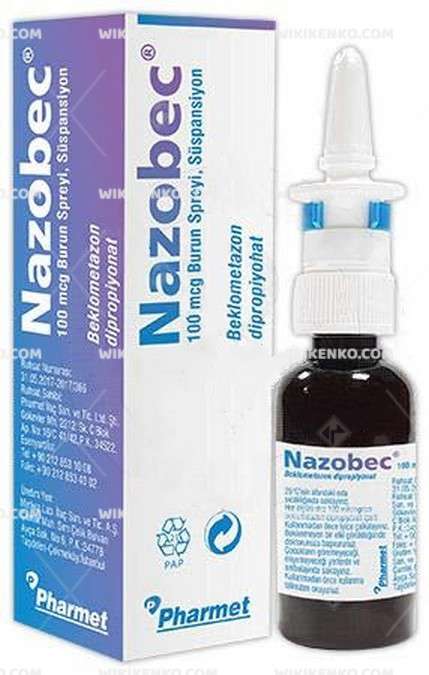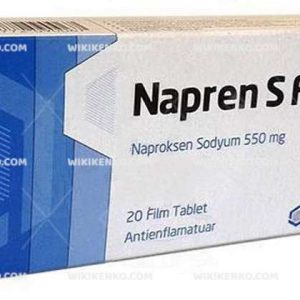Nazobec Nose Spray, Suspension
In this comprehensive guide, we delve into the world of “Nazobec Nose Spray, Suspension,” a nasal suspension medication renowned for its efficacy in addressing various nasal conditions. Amidst some naming confusion, we distinguish it from similar counterparts and elucidate its composition, therapeutic indications, dosage, and storage specifics.
| Dosage form | |
|---|---|
| Pack size | |
| Potency | 100 Mcg / Spraying 200 Doses |
| Manufacturer | |
| Origin | |
| Generic Name (Ingredient) | At Each Spraying Dose; Beklomethasone Dipropionate 100 Micrograms |
Assuming your emergency circumstances for this product, visit Urgent Quotation page. Besides, for any pharmaceutical questions, please ask us in the comments section.
Description
“Nazobec Nose Spray, Suspension” emerges as a versatile nasal suspension spray, coveted for its prowess in alleviating a spectrum of nasal maladies. However, a glance at the search results reveals a naming quagmire, with two distinct nasal sprays vying for attention: “Mometix AQ Nasal Spray” from Turkish sources and “Nasobec Aqueous Nasal Spray” from English sources. Despite the nomenclature intricacies, both aim to combat similar conditions, albeit powered by distinct active ingredients.
Composition and Form of Mometix AQ
“Mometix AQ Nasal Spray” stands distinguished by its active ingredient, Mometasone Furoate Monohydrate (50 mcg/actuation). Each actuation delivers a suspension of 100 mg, equivalent to 50 micrograms of mometasone furoate. Notably, Benzalkonium chloride (0.2 mg/g) contributes as an excipient. The pharmaceutical form manifests as a non-pressurized multiple-use metered-dose aqueous nasal spray suspension.
Therapeutic Indications
Mometix extends its healing touch to both adults and children aged 6 and beyond, offering respite from the throes of seasonal and perennial rhinitis. Furthermore, it serves as a bulwark against seasonal allergic rhinitis in adults and children aged 12 and older, including children as young as 2-6 years old diagnosed with allergic rhinitis. As pollen season looms, prophylactic treatment may commence 2-4 weeks beforehand. For adults aged 18 and above, Mometix dons an additional hat, mitigating nasal polyp-related symptoms such as congestion and diminished olfactory senses.
Administration
For adults, adolescents, and geriatric patients, the standard recommended dose comprises two actuations (50 micrograms/1 actuation) in each nostril once daily, resulting in a total dose of 200 micrograms. Once symptoms relent, a transition to one actuation in each nostril (total dose 100 micrograms) may suffice for maintenance. However, if symptoms persist in their obstinacy, an escalation to a maximum daily dose of four actuations in each nostril once daily (total dose 400 micrograms) remains a viable option. The cardinal rule remains dose reduction following symptom control.
Children aged 2 to 11 years typically receive a usual recommended dose of one actuation (50 micrograms/actuation) in each nostril once daily, amounting to a total dose of 100 micrograms.
Ingredients
“Nasobec Aqueous Nasal Spray” champions Beclometasone Dipropionate as its active ingredient, embracing the aqueous form.
Nazobec Nose Spray Dosage and Storage
Embark on a journey through the intricacies of “Nazobec Aqueous Nasal Spray” dosage and storage to safeguard your nasal well-being.
Dosage
The dosage instructions for “Nazobec Aqueous Nasal Spray” beckon as follows:
- A single spray usually dispenses 50 micrograms of beclometasone.
- The regimen typically entails dual applications daily—once in the morning and once at night.
- The standard dose encompasses 1 or 2 sprays into each nostril.
- Caution prevails against exceeding 4 sprays per nostril within a 24-hour timeframe.
- Upon achieving symptom control, a reduction in spray frequency may be contemplated. For instance, transitioning from 2 sprays twice daily to 1 spray twice daily is a judicious option.
- Vigilance is crucial; should symptoms resurge post-dosage reduction, reinstating the prior dose warrants consideration.
Storage
Regrettably, the search results withhold specific storage instructions for “Nazobec Aqueous Nasal Spray.” As a conventional practice, prudent storage entails a cool, arid abode, safeguarded from direct luminosity and thermal influence. Prudence dictates the elevation of medications beyond the reach of children. For precise storage counsel, perusal of the medication’s packaging, accompanying leaflet, or consultation with a healthcare professional is recommended.
How long can I use Nazobec Nose Spray?
The duration of employing “Nazobec Nose Spray” hinges upon individual symptoms and the counsel of a healthcare provider. Typically, adults and children aged 12 years and above embrace a regimen of 2 sprays into each nostril once daily. Notably, it’s emphasized that certain children may witness a deceleration in growth while under this regimen, underscoring the significance of employing it for the briefest necessary duration to attain symptom alleviation.
For personalized directives, it is incumbent upon the seeker to confer with a healthcare professional. Adherence to prescribed dosages remains pivotal, and discontinuation is warranted in the event of stagnant or aggravated symptoms. Any queries or reservations regarding the duration of “Nazobec Nose Spray” usage should be dutifully presented to a healthcare provider for elucidation.
How does Nazobec compare to other nasal sprays?
“Nazobec Aqueous Nasal Spray” emerges as a formidable steroid nasal spray, fortified by the active ingredient Beclometasone Dipropionate. Its mission extends to the prevention and mitigation of nasal lining inflammation induced by seasonal adversaries like hayfever and perennial adversaries such as animal allergies.
Let’s cast a comparative eye on how it fares in comparison to its nasal spray counterparts:
| Nasal Spray Type | Active Ingredient | Therapeutic Focus |
|---|---|---|
| Steroid Nasal Sprays | Budesonide, Fluticasone, Mometasone, Triamcinolone, Fluticasone Furoate | Alleviating nasal inflammation, congestion, runny nose, and sneezing. In the case of Flonase, it also addresses nonallergic rhinitis and ocular symptoms such as itchy, watery eyes. Nasonex extends its purview to nasal polyps. |
| Antihistamine Sprays | Olopatadine, Azelastine, Astepro | Targeting histamine blockade, especially effective for runny noses due to allergies. OTC versions are also available. |
| Decongestant Sprays | Oxymetazoline, Phenylephrine, Xylometazoline | Temporarily alleviating nasal congestion by constricting blood vessels, reducing swelling. |
| Saline Sprays | Sterile Saline Solution | Maintaining nasal moisture, preventing nosebleeds caused by dryness. |
While each category serves a unique therapeutic purpose, the efficacy of intranasal steroids in the management of chronic rhinosinusitis appears to remain consistent across various agents. It is imperative to seek personalized advice and guidance from a healthcare professional when determining the most suitable nasal spray for your specific needs.
Conclusion
In summation, “Mometix AQ Nasal Spray” and “Nasobec Aqueous Nasal Spray” stand as stalwart allies in the battle against allergic rhinitis and its kin. A pivotal distinction lies in their active ingredients – Mometasone Furoate Monohydrate for Mometix AQ and Beclometasone Dipropionate for Nasobec. Precise adherence to healthcare professional directives remains paramount for optimizing their therapeutic potential.
Use the form below to report an error
Please answer the questions as thoroughly and accurately as possible. Your answers will help us better understand what kind of mistakes happen, why and where they happen, and in the end the purpose is to build a better archive to guide researchers and professionals around the world.
The information on this page is not intended to be a substitute for professional medical advice, diagnosis, or treatment. always seek the advice for your physician or another qualified health provider with any questions you may have regarding a medical condition. Always remember to
- Ask your own doctor for medical advice.
- Names, brands, and dosage may differ between countries.
- When not feeling well, or experiencing side effects always contact your own doctor.
Cyberchondria
The truth is that when we’re sick, or worried about getting sick, the internet won’t help.
According to Wikipedia, cyberchondria is a mental disorder consisting in the desire to independently make a diagnosis based on the symptoms of diseases described on Internet sites.
Why you can't look for symptoms on the Internet
If diagnoses could be made simply from a textbook or an article on a website, we would all be doctors and treat ourselves. Nothing can replace the experience and knowledge of specially trained people. As in any field, in medicine there are unscrupulous specialists, differences of opinion, inaccurate diagnoses and incorrect test results.




Reviews
There are no reviews yet.